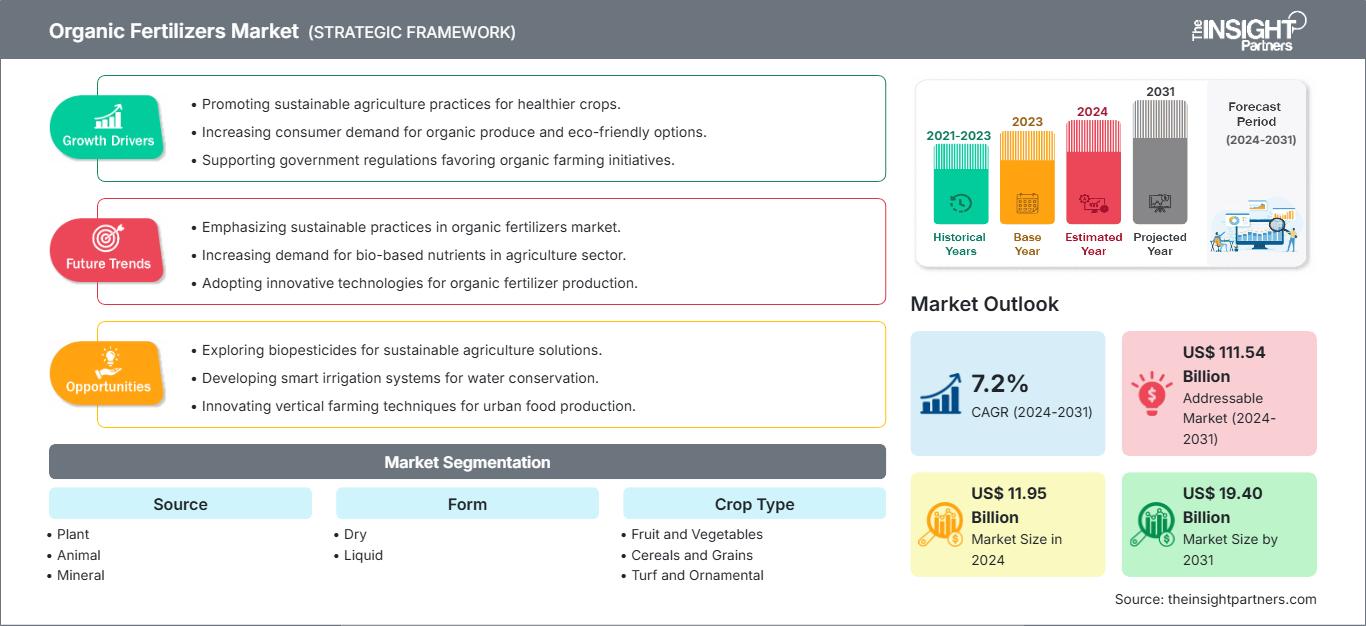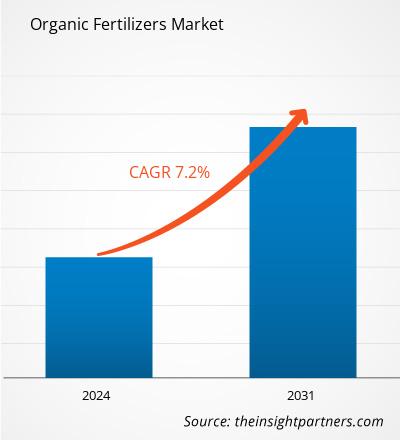Der Markt für organische Düngemittel soll von 11,95 Milliarden US-Dollar im Jahr 2024 auf 19,40 Milliarden US-Dollar im Jahr 2031 anwachsen. Für den Markt wird zwischen 2024 und 2031 eine durchschnittliche jährliche Wachstumsrate (CAGR) von 7,2 % erwartet. Die Einführung der Präzisionslandwirtschaft dürfte im Prognosezeitraum neue Wachstumstrends auf dem Markt für organische Düngemittel mit sich bringen und potenzielle Geschäftsfelder schaffen.
Marktanalyse für organische Düngemittel
Beim Zerfall organischer Materialien werden nach und nach Nährstoffe freigesetzt, wodurch Pflanzen langsam, aber stetig mit Nährstoffen versorgt werden. Im Gegensatz dazu liefern synthetische Düngemittel zwar oft schnell Nährstoffe, können aber zu Nährstoffungleichgewichten, Bodenversauerung und langfristiger Erschöpfung der organischen Bodensubstanz führen. Darüber hinaus erhöhen organische Düngemittel die mikrobielle Aktivität im Boden und fördern ein vielfältiges und ausgewogenes Ökosystem, das den Nährstoffkreislauf, die Pflanzengesundheit und die Widerstandsfähigkeit gegen Schädlinge und Krankheiten unterstützt. Organische Düngemittel sind zwar sehr nützlich, haben aber auch einige Nachteile. Sie enthalten in der Regel geringere Nährstoffkonzentrationen als synthetische Düngemittel, sodass für die gleichen Ergebnisse größere Mengen erforderlich sein können. Der Nährstoffgehalt organischer Düngemittel kann je nach Quelle und Verarbeitungsmethode variieren, was die Vorhersage des genauen Nährstoffprofils erschwert. Trotz dieser Herausforderungen erfreut sich organischer Düngemittel zunehmender Beliebtheit, insbesondere bei Gärtnern, Biobauern und Personen, die sich auf nachhaltige Landwirtschaft konzentrieren. Landwirte und Gärtner können durch den Einsatz organischer Düngemittel ihre Umweltbelastung reduzieren, die Artenvielfalt fördern und gesündere, widerstandsfähigere Ökosysteme schaffen. Insgesamt sind organische Düngemittel entscheidend für die langfristige Erhaltung der Bodenfruchtbarkeit und die Gesundheit von Pflanzen und Umwelt.
Marktübersicht für organische Düngemittel
Organische Düngemittel werden auf natürliche Weise aus pflanzlichen, tierischen und mineralischen Quellen gewonnen und liefern Pflanzen wichtige Nährstoffe. Organische Düngemittel verbessern die Bodenfruchtbarkeit und fördern nachhaltige landwirtschaftliche Praktiken, indem sie die Bodenstruktur verbessern und nützliche Mikroorganismen unterstützen. Sie gelten allgemein als umweltfreundlich, da sie biologisch abbaubar sind und das Risiko von Wasserverschmutzung und Bodendegradation verringern. Organische Düngemittel sind reich an Makronährstoffen (Stickstoff, Phosphor, Kalium usw.) und Mikronährstoffen (Kalzium, Magnesium, Schwefel usw.), die alle für ein gesundes Pflanzenwachstum unerlässlich sind. Tierische Düngemittel sind eine der häufigsten Arten von organischen Düngemitteln; dazu gehört kompostierter Mist von Kühen, Hühnern oder Pferden. Tierische organische Düngemittel sind reich an Stickstoff und organischen Stoffen, die die Bodenstruktur, die Wasserspeicherung und die mikrobielle Aktivität verbessern. Pflanzliche Düngemittel hingegen werden aus Pflanzenmaterialien wie Seetang, Luzernemehl oder kompostierten Ernterückständen hergestellt.
Passen Sie diesen Bericht Ihren Anforderungen an
Sie erhalten kostenlos Anpassungen an jedem Bericht, einschließlich Teilen dieses Berichts oder einer Analyse auf Länderebene, eines Excel-Datenpakets sowie tolle Angebote und Rabatte für Start-ups und Universitäten.
Markt für organische Düngemittel: Strategische Einblicke

- Holen Sie sich die wichtigsten Markttrends aus diesem Bericht.Dieses KOSTENLOSE Beispiel umfasst Datenanalysen, die von Markttrends bis hin zu Schätzungen und Prognosen reichen.
Sie erhalten kostenlos Anpassungen an jedem Bericht, einschließlich Teilen dieses Berichts oder einer Analyse auf Länderebene, eines Excel-Datenpakets sowie tolle Angebote und Rabatte für Start-ups und Universitäten.
Markt für organische Düngemittel: Strategische Einblicke

- Holen Sie sich die wichtigsten Markttrends aus diesem Bericht.Dieses KOSTENLOSE Beispiel umfasst Datenanalysen, die von Markttrends bis hin zu Schätzungen und Prognosen reichen.
Markttreiber und -chancen für organische Düngemittel
Strategische Initiativen von Düngemittelherstellern fördern Marktwachstum
Wichtige Unternehmen im Düngemittelmarkt setzen strategische Initiativen um, um ihre Marktpräsenz auszubauen, die Nachhaltigkeit von Nutzpflanzen zu verbessern und die steigende Verbrauchernachfrage zu erfüllen. Diese Initiativen konzentrieren sich auf Verbesserungen der Lieferkette, technologische Fortschritte, Zertifizierungsprogramme, Partnerschaften sowie Investitionen in Forschung und Entwicklung. Biolebensmittelproduzenten, Einzelhändler, Agrarunternehmen usw. spielen eine entscheidende Rolle bei der Gestaltung des Ökosystems des ökologischen Landbaus. Unternehmen für organische Düngemittel investieren in Agrarforschung und Biotechnologie, um die Herausforderungen des ökologischen Landbaus, darunter geringe Erträge und Schädlingswachstum, zu bewältigen. So erforschen beispielsweise Bayer AG und Syngenta, zwei namhafte Hersteller synthetischer Düngemittel, biofreundliche Düngemittel und Lösungen für die Bodengesundheit. Im März 2023 sammelte Windfall Bio 9 Millionen US-Dollar Startkapital ein, um eine Lösung zur Umwandlung von Methan in organischen Dünger auf den Markt zu bringen. Das Unternehmen plante, die allererste Lösung zur Erfassung und Umwandlung von Methanemissionen in lebenden organischen Dünger zu entwickeln.
Staatliche Vorschriften und Richtlinien unterstützen den ökologischen Landbau und schaffen Wachstumschancen
Regierungen implementieren Vorschriften und Richtlinien zur Förderung des ökologischen Landbaus als Teil ihrer umfassenderen Strategien für Nachhaltigkeit und Ernährungssicherheit. Diese Richtlinien konzentrieren sich auf finanzielle Anreize, Zertifizierungsstandards und Forschungsunterstützung, um die allgemeine Marktentwicklung zu unterstützen und den Übergang von der konventionellen zur ökologischen Landwirtschaft zu fördern. Fast alle EU-Mitgliedstaaten unterstützen den ökologischen Landbau durch EU-weite gesetzliche Definitionen, Zahlungen für die Umstellung auf Agrarumweltmaßnahmen und deren Erhaltung, Marketing- und Verarbeitungszuschüsse für die ländliche Entwicklung, Förderinitiativen, öffentliche Beschaffung sowie Forschungs- und Informationsinitiativen. Im Jahr 2020 führte die Europäische Kommission die Strategie „Vom Hof auf den Tisch“ ein, die eine Reihe von Zielen zur Verbesserung der Nachhaltigkeit in der Lebensmittelproduktion in der EU festlegte. Diese Ziele umfassen eine 50-prozentige Reduzierung des Pestizideinsatzes und eine 20-prozentige Verringerung des Düngemitteleinsatzes; außerdem soll der Anteil des ökologischen Landbaus an der gesamten landwirtschaftlichen Nutzfläche auf 25 % gesteigert werden. Im Jahr 2022 startete das US-Landwirtschaftsministerium die Organic Transition Initiative mit einer Investition von 300 Millionen US-Dollar, die eine Reihe von Programmen und Ressourcen bietet, um bestehende Biobauern und solche, die in den USA auf ökologische Produktion und Verarbeitung umsteigen, zu unterstützen.
Segmentierungsanalyse des Marktberichts zu organischen Düngemitteln
Schlüsselsegmente, die zur Ableitung der Marktanalyse für organische Düngemittel beigetragen haben, sind Quelle, Form und Ernteart.
- Nach Quelle ist der Markt für organische Düngemittel in Pflanzen, Tiere und Mineralien segmentiert. Das Segment Pflanzen hatte 2024 den größten Marktanteil.
- Basierend auf der Form ist der Markt in trocken und flüssig unterteilt. Das Trockensegment dominierte den Markt im Jahr 2024.
- Basierend auf der Anbauart ist der Markt in Obst und Gemüse, Getreide und Körner, Rasen und Zierpflanzen, Blumen und Baumschulen, Baumfrüchte, Hülsenfrüchte, Kräuter und Gewürze, Ölsaaten, Knollen- und Wurzelgemüse und Sonstiges unterteilt. Das Ölsaatensegment hatte 2024 den größten Marktanteil.
Marktanteilsanalyse für organische Düngemittel nach Geografie
Der geografische Umfang des Marktberichts für organische Düngemittel ist in fünf Regionen unterteilt: Nordamerika, Asien-Pazifik, Europa, Naher Osten und Afrika sowie Süd- und Mittelamerika. Der Markt für organische Düngemittel im Asien-Pazifik-Raum wird im Prognosezeitraum voraussichtlich deutlich wachsen.
Unter den Ländern im Asien-Pazifik-Raum weist Australien eine erhebliche Nachfrage nach organischen Düngemitteln auf, was mit einer Vergrößerung der biologisch angebauten Anbauflächen verbunden sein kann. Laut IFOAM – Laut Organics International ist Australien das Land mit der weltweit größten Bio-Landwirtschaftsfläche. Die Fläche für den Bio-Anbau stieg 2022 im Vergleich zu 2021 um 17,3 Millionen Hektar auf insgesamt 53 Millionen Hektar. Das Land setzt auf nachhaltige Landwirtschaft, unterstützt durch staatliche Maßnahmen und Initiativen. So hat die australische Regierung beispielsweise das Programm für klimafreundliche Landwirtschaft (Climate-Smart Agriculture Program) für 2023–2024 ins Leben gerufen, das über einen Zeitraum von fünf Jahren läuft und 185,38 Millionen US-Dollar investiert. Ziel des Programms ist die Förderung von Nachhaltigkeit, Produktivität und Wettbewerbsfähigkeit in der Landwirtschaft. Der starke Bio-Landwirtschaftssektor und unterstützende Regierungsinitiativen fördern das Wachstum des Biodüngermarktes im Land.
Markt für BiodüngerMarkt für organische Düngemittel
Die Analysten von The Insight Partners haben die regionalen Trends und Faktoren, die den Markt für organische Düngemittel im Prognosezeitraum beeinflussen, ausführlich erläutert. In diesem Abschnitt werden auch die Marktsegmente und die geografische Verteilung organischer Düngemittel in Nordamerika, Europa, im asiatisch-pazifischen Raum, im Nahen Osten und Afrika sowie in Süd- und Mittelamerika erläutert.Umfang des Marktberichts über organische Düngemittel
Berichtsattribut
Einzelheiten
Marktgröße in 2024
US$ 11.95 Billion
Marktgröße nach 2031
US$ 19.40 Billion
Globale CAGR (2024 - 2031)
7.2%
Historische Daten
2021-2023
Prognosezeitraum
2024-2031
Abgedeckte Segmente
By Quelle - Pflanze
- Tier
- Mineral
By Form- trocken
- flüssig
By Pflanzenart- Obst und Gemüse
- Getreide und Körner
- Rasen und Zierpflanzen
- Blumen und Baumschulen
- Baumfrüchte
- Hülsenfrüchte
- Kräuter und Gewürze
- Ölsaaten
- Knollen und Wurzelgemüse
Abgedeckte Regionen und Länder
Nordamerika- USA
- Kanada
- Mexiko
Europa- Großbritannien
- Deutschland
- Frankreich
- Russland
- Italien
- Restliches Europa
Asien-Pazifik- China
- Indien
- Japan
- Australien
- Restlicher Asien-Pazifik
Süd- und Mittelamerika- Brasilien
- Argentinien
- Restliches Süd- und Mittelamerika
Naher Osten und Afrika- Südafrika
- Saudi-Arabien
- Vereinigte Arabische Emirate
- Restlicher Naher Osten und Afrika
Marktführer und wichtige Unternehmensprofile - Agrocare Canada
- Biostar Renewables LLC
- Coromandel International Limited
- Italpolina SPA
- Midwestern BioAg
- Krishak Bharati Cooperative Limited
- National Fertilizers Limited
- Perfect Blend Biotic Fertilizer
- ScottsMiracle-Gro
- Natural Fertilizer Inc
Dichte der Marktteilnehmer für organische Düngemittel: Verständnis ihrer Auswirkungen auf die Geschäftsdynamik
Der Markt für organische Düngemittel wächst rasant. Die steigende Nachfrage der Endverbraucher ist auf Faktoren wie veränderte Verbraucherpräferenzen, technologische Fortschritte und ein stärkeres Bewusstsein für die Produktvorteile zurückzuführen. Mit der steigenden Nachfrage erweitern Unternehmen ihr Angebot, entwickeln Innovationen, um den Bedürfnissen der Verbraucher gerecht zu werden, und nutzen neue Trends, was das Marktwachstum weiter ankurbelt.
- Holen Sie sich die Markt für organische Düngemittel Übersicht der wichtigsten Akteure
Markt für organische Düngemittel
Die Analysten von The Insight Partners haben die regionalen Trends und Faktoren, die den Markt für organische Düngemittel im Prognosezeitraum beeinflussen, ausführlich erläutert. In diesem Abschnitt werden auch die Marktsegmente und die geografische Verteilung organischer Düngemittel in Nordamerika, Europa, im asiatisch-pazifischen Raum, im Nahen Osten und Afrika sowie in Süd- und Mittelamerika erläutert.Umfang des Marktberichts über organische Düngemittel
| Berichtsattribut | Einzelheiten |
|---|---|
| Marktgröße in 2024 | US$ 11.95 Billion |
| Marktgröße nach 2031 | US$ 19.40 Billion |
| Globale CAGR (2024 - 2031) | 7.2% |
| Historische Daten | 2021-2023 |
| Prognosezeitraum | 2024-2031 |
| Abgedeckte Segmente |
By Quelle
|
| Abgedeckte Regionen und Länder | Nordamerika
|
| Marktführer und wichtige Unternehmensprofile |
|

- Holen Sie sich die Markt für organische Düngemittel Übersicht der wichtigsten Akteure
Neuigkeiten und aktuelle Entwicklungen zum Markt für organische Düngemittel
Der Markt für organische Düngemittel wird durch die Erhebung qualitativer und quantitativer Daten aus Primär- und Sekundärforschung bewertet, die wichtige Unternehmensveröffentlichungen, Verbandsdaten und Datenbanken umfasst. Einige der wichtigsten Entwicklungen auf dem Markt für organische Düngemittel sind wie folgt:
- Im Dezember 2024 gaben Coromandel International Limited (Indiens führender Anbieter von Agrarlösungen) und Krish-e [Geschäftsbereich Farm Equipment Sector (FES) von Mahindra & Mahindra Limited] eine Partnerschaft bekannt, um Coromandels Drohnen-Sprühdienste Gromor Drive auf indische Landwirte auszuweiten. (Quelle: Coromandel International Limited, Unternehmenswebsite, Dezember 2024)
- The Andersons, Inc. schloss den Erwerb einer Mehrheitsbeteiligung an Skyland Grain, LLC ab. Durch die Transaktion kann The Andersons sein Kerngeschäft im Bereich Getreide und Düngemittel auf strategische Märkte wie Kansas, Oklahoma, Colorado und Texas ausweiten. (Quelle: The Andersons, Inc., Pressemitteilung, November 2024)
Bericht zum Markt für organische Düngemittel: Umfang und Ergebnisse
Der Bericht „Marktgröße und Prognose für organische Düngemittel (2021–2031)“ bietet eine detaillierte Analyse des Marktes in den folgenden Bereichen:
- Marktgröße und Prognose für organische Düngemittel auf globaler, regionaler und Länderebene für alle wichtigen Marktsegmente, die im Rahmen abgedeckt sind
- Markttrends für organische Düngemittel sowie Marktdynamik wie Treiber, Einschränkungen und wichtige Chancen
- Detaillierte Porter's Five Forces- und SWOT-Analyse
- Marktanalyse für organische Düngemittel mit wichtigen Markttrends, globalen und regionalen Rahmenbedingungen, wichtigen Akteuren, Vorschriften und aktuellen Marktentwicklungen
- Branchenlandschaft und Wettbewerbsanalyse mit Marktkonzentration, Heatmap-Analyse, prominenten Akteuren und aktuellen Entwicklungen für organische Düngemittel Markt
- Detaillierte Unternehmensprofile
- Historische Analyse (2 Jahre), Basisjahr, Prognose (7 Jahre) mit CAGR
- PEST- und SWOT-Analyse
- Marktgröße Wert/Volumen – Global, Regional, Land
- Branchen- und Wettbewerbslandschaft
- Excel-Datensatz
Aktuelle Berichte
Verwandte Berichte
Erfahrungsberichte
Grund zum Kauf
- Fundierte Entscheidungsfindung
- Marktdynamik verstehen
- Wettbewerbsanalyse
- Kundeneinblicke
- Marktprognosen
- Risikominimierung
- Strategische Planung
- Investitionsbegründung
- Identifizierung neuer Märkte
- Verbesserung von Marketingstrategien
- Steigerung der Betriebseffizienz
- Anpassung an regulatorische Trends






















 Kostenlose Probe anfordern für - Markt für organische Düngemittel
Kostenlose Probe anfordern für - Markt für organische Düngemittel